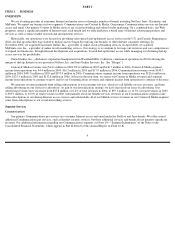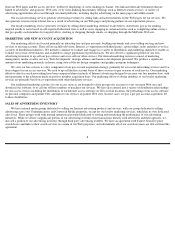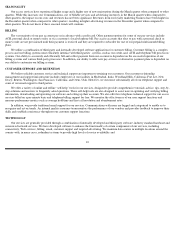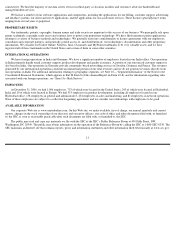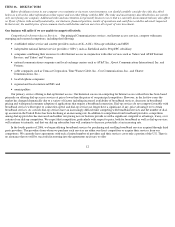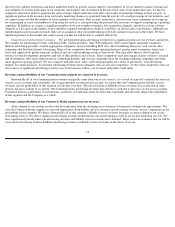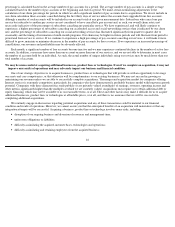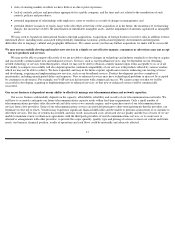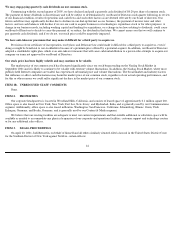Classmates.com 2006 Annual Report Download - page 14
Download and view the complete annual report
Please find page 14 of the 2006 Classmates.com annual report below. You can navigate through the pages in the report by either clicking on the pages listed below, or by using the keyword search tool below to find specific information within the annual report.
broadband services on a significant scale, that we will be able to maintain such agreements or that the pricing under such agreements will enable
us to profitably resell the services. Most of the largest providers of broadband services, such as cable and telecommunications companies, control
their own networks and offer a wider variety of services than we offer, including phone, data and video services and content. Their ability to
bundle services and to offer broadband services at prices below the price that we can profitably offer comparable services puts us at a
competitive disadvantage. Decreases in retail broadband pricing as a result of competition would adversely impact our ability to offer such
services profitably or at a competitive price. We only have a limited number of subscribers to our broadband services and there can be no
assurance that our broadband services will be commercially successful.
In order to compete effectively we may have to make significant revisions to our services, pricing and marketing strategies, and business
model. For example, we may have to lower our introductory rates, offer additional free periods of service, offer additional features at little or no
additional cost to the consumer, and/or reduce the standard pricing of our services. Measures such as these could decrease our revenues and our
average revenue per pay access account. We may also have to allocate more marketing resources toward our access services than we anticipate.
All of the foregoing could adversely affect the profitability of our access services which could materially and adversely impact our financial
condition, results of operations and cash flows.
Competition for Social-Networking Services. Competition for subscribers in the social-networking market is intense and rapidly evolving.
Our social-networking services compete directly against a small number of companies, including Reunion.com and Monster.com’s Military.com
service, offering similar online social-networking services based on work, school and military communities. Our social-networking services also
compete directly with many schools, employers, Web sites, and associations that maintain their own Internet-based alumni information services.
In addition to this direct competition, we compete for subscribers with companies offering a wide variety of social-networking and search
services, including Web portals such as Yahoo!, MSN and AOL, and other community-based Web sites; personal-networking communities such
as MySpace, Facebook and Friendster; and search services that help users locate individuals such as Google. Some of these services also have a
wider variety of services and more sophisticated features than ours. Our social-networking services are used primarily to locate and contact
acquaintances from school, work or military affiliations, and our subscribers, in general, do not spend a significant amount of time on the site for
other purposes. Many social-networking services are free or only require payment if certain additional functionality is desired by the user. The
continued prevalence of free services could adversely impact our ability to market both our free and pay social-
networking services, maintain our
current price levels, or maintain or grow our pay account base at current price levels, or at all.
Many competitors in this market have longer operating histories, larger customer bases, greater brand recognition and significantly greater
financial, marketing and other resources than we do. In addition, we have relied extensively on Internet advertising through portals and other
Internet service providers, including AOL, MSN and Yahoo!, to grow our free and pay accounts. A number of these companies are competitors
of United Online with respect to Internet access and other services, and they may not be willing to retain the same advertising relationship going
forward. To the extent we are not able to maintain advertising relationships with these companies, our ability to obtain new social-networking
pay and free accounts would be adversely impacted.
Competition for Online Loyalty Marketing Services. Our loyalty marketing buisness faces competition for members from other loyalty
programs that offer competitive online products and services. Currently, several companies offer competitive online products and services,
including Ebates, Upromise and Points.com. We also face competition from larger offline loyalty point programs, such as those operated by
credit card companies, airlines and hotels, to the extent they focus on developing a stronger online presence or promote online shopping
opportunities. The success of our loyalty marketing business largely depends on our ability to maintain and expand an active membership base.
Our revenues are primarily
13



